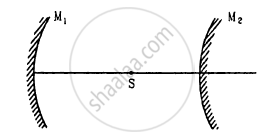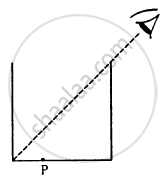Advertisements
Advertisements
प्रश्न
A concave mirror having a radius of curvature 40 cm is placed in front of an illuminated point source at a distance of 30 cm from it. Find the location of the image.
उत्तर
Using sign conventions, given,
Distance of object from mirror, u = − 30 cm,
Radius of curvature of concave mirror R = − 40 cm
Using the mirror equation,
\[\frac{1}{v} + \frac{1}{u} = \frac{2}{R}\]
\[ \Rightarrow \frac{1}{v} = \frac{2}{R} - \frac{1}{u}\]
\[ \Rightarrow \frac{1}{v} = \frac{2}{- 40} - \frac{1}{- 30} = \frac{1}{- 20} + \frac{1}{30}\]
\[ \Rightarrow \frac{1}{v} = \frac{- 30 + 20}{30 \times 20} = \frac{- 10}{30 \times 20}\]
\[ \Rightarrow \frac{1}{v} = - \frac{1}{60}\]
or, v = − 60 cm
Hence, the required image will be located at a distance of 60 cm in front of the concave mirror.
APPEARS IN
संबंधित प्रश्न
Why does unpolarised light from a source show a variation in intensity when viewed through a polaroid which is rotated?
Show with the help of a diagram, how unpolarised light from Sun gets linearly polarised by scattering.
Draw the intensity distribution for the fringes produced in interference ?
A parallel beam of light is incident on a converging lens parallel to its principal axis. As one moves away from the lens on the other side on its principal axis, the intensity of light
A concave mirror forms an image of 20 cm high object on a screen placed 5.0 m away from the mirror. The height of the image is 50 cm. Find the focal length of the mirror and the distance between the mirror and the object.
A concave mirror has a focal length of 20 cm. Find the position or positions of an object for which the image-size is double of the object-size.
A 3 cm tall object is placed at a distance of 7.5 cm from a convex mirror of focal length 6 cm. Find the location, size and nature of the image.
A converging mirror M1, a point source S and a diverging mirror M2 are arranged as shown in figure. The source is placed at a distance of 30 cm from M1. The focal length of each of the mirrors is 20 cm. Consider only the images formed by a maximum of two reflections. It is found that one image is formed on the source itself. (a) Find the distance between the two mirrors. (b) Find the location of the image formed by the single reflection from M2.

k transparent slabs are arranged one over another. The refractive indices of the slabs are μ1, μ2, μ3, ... μk and the thicknesses are t1 t2, t3, ... tk. An object is seen through this combination with nearly perpendicular light. Find the equivalent refractive index of the system which will allow the image to be formed at the same place.
A cylindrical vessel, whose diameter and height both are equal to 30 cm, is placed on a horizontal surface and a small particle P is placed in it at a distance of 5.0 cm from the centre. An eye is placed at a position such that the edge of the bottom is just visible (see figure). The particle P is in the plane of drawing. Up to what minimum height should water be poured in the vessel to make the particle P visible?

An optical fibre (μ = 1.72) is surrounded by a glass coating (μ = 1.50). Find the critical angle for total internal reflection at the fibre-glass interface.
A biconvex thick lens is constructed with glass (μ = 1.50). Each of the surfaces has a radius of 10 cm and the thickness at the middle is 5 cm. Locate the image of an object placed far away from the lens.
One end of a cylindrical glass rod (μ = 1.5) of radius 1.0 cm is rounded in the shape of a hemisphere. The rod is immersed in water (μ = 4/3) and an object is placed in the water along the axis of the rod at a distance of 8.0 cm from the rounded edge. Locate the image of the object.
A paperweight in the form of a hemisphere of radius 3.0 cm is used to hold down a printed page. An observer looks at the page vertically through the paperweight. At what height above the page will the printed letters near the centre appear to the observer?
Fill in the blank and rewrite the completed statement:
Very fine particles mainly scatter ______ light.
Explain: ‘How is a rainbow formed’?
Answer the following question in detail.
Explain the formation of a primary rainbow. For which angular range with the horizontal is it visible?
A plano-convex lens is made of material having refractive index 1.5. The radius of curvature of curved surface is 40 cm. The focal length of the lens is ____________ cm.
The sky would appear red instead of blue if
A passenger in an aeroplane shall ______.
